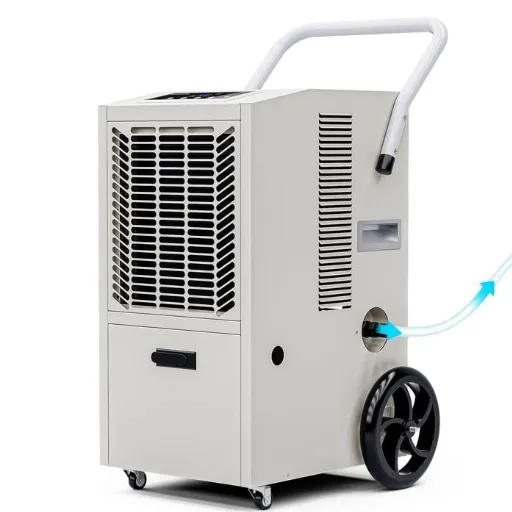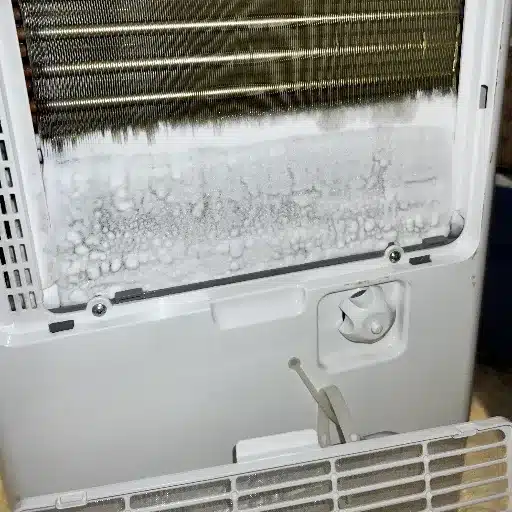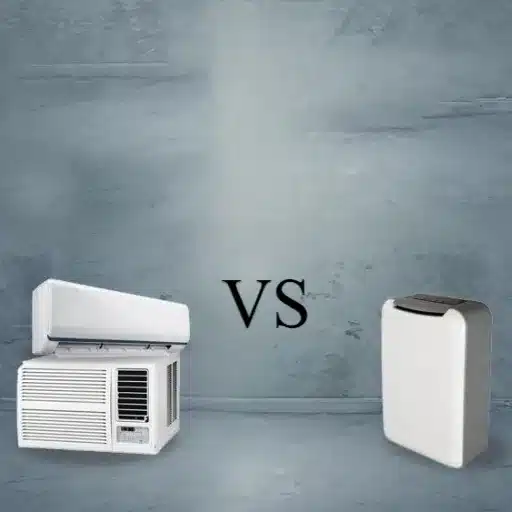Maintaining a comfortable and refreshing indoor environment is no small challenge, especially during sweltering summer months or in humid climates. Enter the Evaporative Air Cooler Dehumidifier, a versatile and energy-efficient solution designed to tackle two common concerns simultaneously—excess heat and moisture. This innovative appliance combines the cooling power of evaporative technology with the moisture-reducing capabilities of a dehumidifier, creating a balanced and breathable indoor atmosphere. But what makes it stand out from traditional air conditioning systems or standalone dehumidifiers? In this guide, we’ll explore the key features, functional benefits, and practical applications of the Evaporative Air Cooler Dehumidifier, helping you understand why it may be the ideal choice for your home or workspace.
What is an Evaporative Cooler and How Does it Differ from a Dehumidifier?
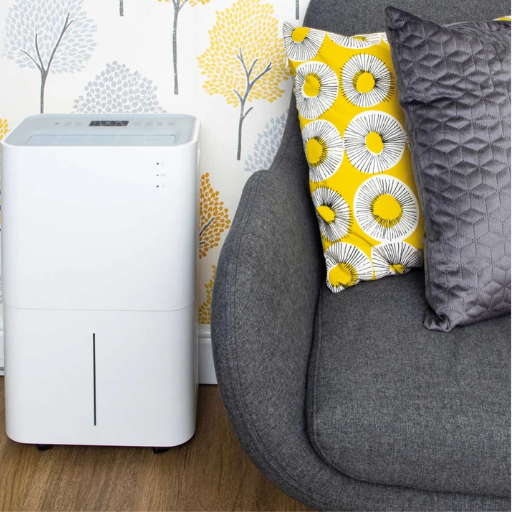
Despite relatively similar functions in regulating the quality of indoor air, an evaporative cooler and a dehumidifier have unique differences. An evaporative cooler, or swamp cooler, pulls in warm air and passes it through moistened pads. The water subsequently absorbs the heat and evaporates, resulting in cooler air entering the space. An evaporative cooler is effective in dry climates since it lowers the temperature and adds moisture.
On the other hand, dehumidifiers are used to lower excess moisture in the air and, as such, work better in hot and humid conditions. Unlike evaporative coolers, dehumidifiers do not cool the air drastically. Instead, a dehumidifier is effective in creating a dry atmosphere where the chance of moisture will minimize mold growth, thus improving comfort.
Your choice will depend on the specific climate and the indoor air needs, while the primary difference remains in the function: evaporative coolers add humidity while dehumidifiers eliminate moisture.
Basic Principles of Evaporative Cooling
Evaporative cooling operates on a simple yet highly effective principle: the absorption of heat through water evaporation. When water transitions from liquid to vapor, it absorbs heat energy from the surrounding air, resulting in a noticeable drop in temperature. This process is most effective in hot and dry climates where humidity levels are naturally low, allowing for greater evaporation potential.
Modern evaporative coolers are designed to maximize this natural process. A standard system includes a water reservoir, cooling pads, and a fan. The fan draws warm air through the moisture-saturated cooling pads, where the water absorbs heat and evaporates, cooling the air before it is circulated into the living space. Studies have shown that well-maintained evaporative cooling systems can reduce indoor temperatures by up to 20-40°F, depending on external conditions.
Additionally, evaporative cooling is incredibly energy-efficient. Unlike traditional air conditioners, which rely on refrigerants and compressors, evaporative coolers consume up to 75% less electricity, providing an eco-friendly and cost-effective cooling solution. For instance, in a midsize room using a portable evaporative cooler, the average energy usage can be just 100–300 watts per hour, compared to around 1,500 watts for traditional air conditioning units.
This cooling method also improves air quality by filtering out dust and pollen particles as the air passes through the damp pads. By incorporating features like adjustable fan speeds, smart humidity sensors, and improved water circulation, modern evaporative cooling technologies are making it easier than ever to achieve a comfortable and sustainable indoor environment.
Comparing Humidity Control: Dehumidification vs. Evaporative Air Cooling
When it comes to indoor humidity control, dehumidification and evaporative air cooling serve distinct purposes, catering to different climate needs and environments. Dehumidification works by removing excess moisture from the air, which is especially crucial in high-humidity regions where dampness can lead to mold growth, discomfort, and even structural damage. Dehumidifiers achieve this by drawing in humid air, condensing the moisture on cold coils, and releasing drier, more breathable air. Modern dehumidifiers are highly efficient, with energy consumption often as low as 0.3 kWh per hour, depending on capacity, and user-friendly features like programmable humidity levels and auto-shutoff functions.
On the other hand, evaporative air cooling is more suited to hot and dry climates. This process utilizes the natural cooling effect of water evaporation to reduce air temperature and add moisture back into dry indoor air. It can be up to 75% more energy-efficient compared to traditional air conditioners, consuming as little as 0.2 kWh per hour in many units. Additionally, evaporative coolers simultaneously filter air, removing particles like dust and allergens. However, their effectiveness is highly dependent on ambient humidity and may not deliver optimal results in areas with already high humidity levels.
Thus, the choice between dehumidification and evaporative cooling ultimately depends on balancing the requirements of the surrounding climate with the specific humidity and comfort needs of a space. Recent advancements in both technologies have further enhanced their efficiency and adaptability, ensuring that consumers can achieve precise humidity control tailored to their environment.
The Role of Moisture in Evaporative Humidifiers
Moisture plays a fundamental role in the operation of evaporative humidifiers, as it directly influences their efficiency and performance. These devices function by drawing in dry air, passing it over a moistened surface (commonly a wick or filter), and releasing humidified air back into the room. The process hinges on the principle of evaporation, where water molecules transition from the liquid state to vapor, thereby increasing the relative humidity of the surrounding environment.
Studies indicate that evaporative humidifiers work best when relative humidity levels are below 50%, as the lower ambient humidity accelerates the evaporation process. For instance, a standard evaporative humidifier can add up to 2-4 gallons of moisture to the air daily, depending on the unit’s capacity and the dryness of the space. The humidity output is measured in gallons per day (GPD), and many modern models come equipped with hygrometers and auto-regulation features to maintain optimal levels, typically between 30-50% relative humidity.
An important factor to consider is the quality of water used. Hard water, which contains high mineral content, can lead to the buildup of white dust (mineral deposits) and reduce the lifespan of wicks and filters. To mitigate this, many evaporative humidifiers are now designed to support the use of demineralized water or include filters capable of minimizing mineral dispersion.
Advancements in technology have also introduced features like antimicrobial-treated components, ensuring that moisture added to the air is free of contaminants, promoting better air quality. Additionally, integrating smart controls into evaporative humidifiers allows users to monitor and adjust humidity levels in real-time through mobile applications, enhancing both efficiency and user convenience.
Ultimately, moisture is not just a critical element but the driving force behind the mechanism of evaporative humidifiers. By controlling indoor humidity effectively, these devices contribute to healthier living spaces, improving respiratory comfort, skin hydration, and even protecting wooden furniture and artwork from excessive dryness.
How Does Evaporative Cooling Affect Indoor Air Quality?
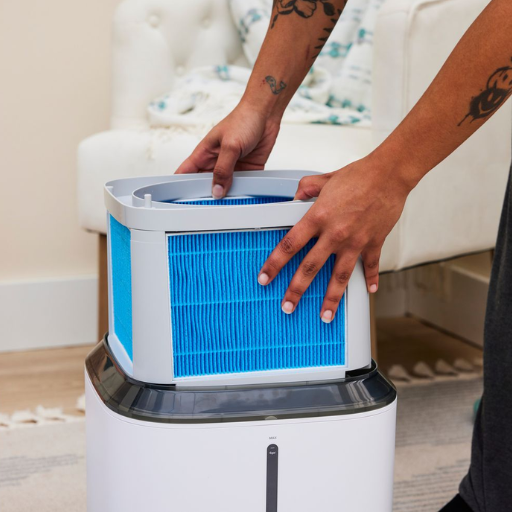
The process of evaporative cooling serves to enhance the air quality indoors by bringing in fresh air that is rich in moisture. This helps alleviate dryness which may cause respiratory problems, skin irritations, or other health-related issues. Moreover, the air circulation exchange can eliminate lingering stale smells, pollutants, and allergens resulting in a cleaner environment. In contrast to other cooling techniques that use chemical refrigerants, evaporative cooling uses water to humidify and cool the air, making this method environmentally friendly and improves the quality of air in the space in a positive way.
Impact on Relative Humidity and Moisture Levels
Evaporative cooling has a significant influence on relative humidity and moisture levels, making it an effective solution for certain climates. By utilizing the principle of water evaporation, this system introduces moisture into the air as it cools. For instance, studies show that in arid regions, where relative humidity levels can drop below 30%, evaporative cooling systems can boost indoor humidity levels to a more comfortable range between 50% and 60%. This increase not only enhances comfort but also prevents issues such as dry skin and respiratory irritation that are common in low-humidity environments.
However, in humid climates where the relative humidity is already above 60%, the addition of moisture through evaporative cooling may not be as effective or desirable. Excessive humidity can lead to dampness, condensation on surfaces, and potential mold growth. Therefore, these systems are best suited for dry or semi-arid environments where they can balance both temperature and moisture levels efficiently. Data also highlights that in optimal conditions, these cooling systems can reduce indoor temperatures by up to 20°F, creating a cooler and more balanced atmosphere.
Benefits of Fresh Air Circulation and Ventilation
Fresh air circulation and proper ventilation play a pivotal role in maintaining indoor air quality and overall well-being. Research indicates that adequate ventilation minimizes indoor air pollutants such as carbon dioxide, volatile organic compounds (VOCs), and airborne pathogens. This can significantly reduce health risks, including allergies, respiratory issues, and fatigue.
Furthermore, bringing fresh air indoors helps regulate humidity levels, preventing problems like mold growth and structural damage caused by excess moisture. Modern studies have shown that increasing ventilation rates in buildings by just 20-30% can lead to improved cognitive performance and productivity, particularly in workplaces and educational settings.
Improved ventilation also supports temperature regulation, working in tandem with cooling or heating systems to distribute air evenly throughout a building. This ensures a consistent and comfortable environment, enhancing energy efficiency. Regular air exchange reduces the spread of airborne illnesses, including those caused by viruses and bacteria, making fresh air and ventilation critical in both residential and commercial spaces for promoting health, comfort, and safety.
Managing Indoor Humidity in Arid Climates
Managing indoor humidity in arid climates is essential for maintaining a comfortable and healthy living environment. Arid regions are characterized by extremely low levels of humidity, often below 30%, which can lead to dry skin, irritated respiratory systems, and an increased risk of dehydration. To combat these effects, adding moisture to the air through appliances like humidifiers is a practical solution. Studies suggest that maintaining indoor relative humidity between 30% and 50% helps to minimize health risks and improve overall comfort.
Indoor plants can also play a role in increasing humidity naturally, as they release water vapor during photosynthesis. Additionally, hanging damp towels, placing bowls of water near windows, or using an evaporative cooler are low-cost methods to maintain adequate moisture levels.
Proper insulation in arid climates is equally vital to regulate indoor humidity. Poorly sealed windows and doors can cause further drying, while insulating materials help to maintain a stable indoor atmosphere. Energy-efficient practices such as sealing air leaks and using double-pane windows not only conserve energy but also assist in retaining some humidity. Addressing the dry conditions systematically ensures a balance that promotes wellness, reduces static electricity, and prevents damage to wooden furniture and floors.
Are Portable Evaporative Coolers Effective for Indoor Use?
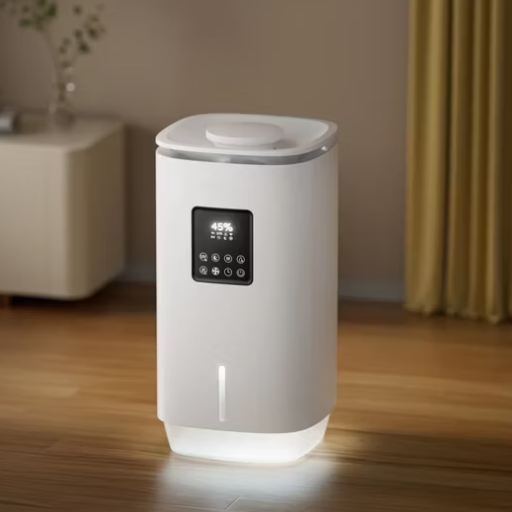
Portable evaporative coolers can be effective for indoor use, especially in dry climates where humidity levels are low. Their efficiency relies on their ability to cool air by passing it through water-soaked pads, which adds moisture and lowers the air temperature. These coolers are energy-efficient, cost-effective, and provide better airflow compared to traditional fans. However, they are less effective in humid environments, as the added moisture may not evaporate efficiently, reducing their cooling capacity. For optimal performance, proper ventilation and regular maintenance, like cleaning the pads and ensuring adequate water levels, are essential.
Advantages of Portable Evaporative Air Coolers
- Energy Efficiency
Portable evaporative air coolers consume significantly less energy compared to traditional air conditioning systems. On average, they use up to 75% less electricity, making them an environmentally friendly and cost-effective cooling solution. This reduced energy consumption helps minimize power bills, especially during peak summer months when cooling demands are at their highest.
- Eco-Friendly Cooling
These coolers rely on a natural cooling process—evaporation—which does not involve harmful refrigerants like CFCs or HFCs commonly found in air conditioners. This makes them a sustainable option that contributes to reducing greenhouse gas emissions.
- Enhanced Air Quality
By drawing in fresh air and passing it through water-saturated cooling pads, these devices provide a continuous flow of clean, moist air. This process not only cools the space but also removes dust and other airborne impurities, improving overall indoor air quality.
- Portability and Flexibility
Compact and lightweight in design, portable evaporative coolers can be easily moved to different areas, allowing users to cool specific spaces as needed. They are particularly ideal for personal use, patios, outdoor areas, and small offices.
- Cost-Effective Operation
Unlike traditional air conditioners, portable evaporative coolers have a lower upfront cost and require minimal maintenance. Replacement parts, such as cooling pads, are inexpensive, and routine upkeep ensures long-term, efficient functioning without heavy financial investment.
- Low Water Consumption
Despite using water to facilitate the evaporation process, modern portable coolers are designed to be water-efficient. On average, a unit uses 1–3 gallons of water per hour, making it a practical choice even in regions with limited water availability.
- Better Performance in Dry Climates
For areas with hot and arid conditions, such as deserts or regions with low humidity, evaporative coolers are highly effective. The dry climate supports efficient evaporation, ensuring faster and more consistent cooling.
By offering a combination of affordability, sustainability, and convenience, portable evaporative air coolers are an excellent solution for cooling needs in specific climates. Their versatile design and eco-friendly operation make them a valuable addition to homes and workplaces.
Considerations for Indoor Air Temperature and Humidity
Maintaining an ideal indoor air temperature and humidity is crucial for ensuring comfort, health, and energy efficiency. Experts generally recommend keeping indoor temperatures between 68°F and 76°F for optimal comfort, depending on the season and individual preference. Similarly, indoor humidity should be kept at a level between 30% and 50%. Levels below 30% can lead to discomfort, dry skin, and respiratory issues, while levels exceeding 50% can contribute to the growth of mold, bacteria, and dust mites.
The relationship between temperature and humidity plays a significant role in perceived comfort. For example, higher humidity can make warm temperatures feel even hotter due to the reduced effectiveness of sweat evaporation, which is the body’s natural cooling mechanism. Conversely, overly dry air in a heated environment can cause skin and respiratory irritation, as well as static electricity buildup.
Using tools such as a programmable thermostat and a hygrometer can aid in monitoring and maintaining these levels efficiently. Modern solutions include smart thermostats that adjust temperatures automatically and humidifiers or dehumidifiers that address extreme moisture levels in an energy-conscious manner. Additionally, seasonal adaptations like sealing gaps around windows and using thermal insulation can improve indoor climate control, reducing energy costs while enhancing comfort year-round.
Using Portable Units in Different Climates
Portable climate control units, such as portable air conditioners, dehumidifiers, and heaters, offer unparalleled flexibility in managing indoor environments across diverse climates. These units are particularly beneficial in situations where permanent installations are not feasible or cost-effective.
Hot and Humid Climates
In tropical and subtropical regions, high humidity and intense heat can quickly make indoor spaces uncomfortable. Portable air conditioners combined with dehumidifiers are ideal for these environments. Modern portable air conditioners not only cool the air but also feature energy-efficient designs with variable speed compressors, reducing power consumption significantly. For example, an 8,000 BTU portable air conditioner can efficiently cool a room of up to 200 square feet, using approximately 1.2 kWh of energy per hour. Simultaneously, portable dehumidifiers can extract excess moisture from the air, with many models capable of removing up to 50 pints of water per day, thereby preventing mold and improving air quality in high-humidity zones.
Cold and Dry Climates
In colder climates where dryness is a common issue, portable heaters and humidifiers are essential. State-of-the-art ceramic or infrared heaters are known for their rapid warming capabilities while operating quietly, perfect for small apartments or offices. Many models include features like adjustable thermostats and timers, contributing to both comfort and energy efficiency. Portable humidifiers, on the other hand, regulate dry air by dispersing fine water vapor, enhancing respiratory health and preventing skin irritation. For example, a compact ultrasonic humidifier with a one-gallon capacity can effectively increase humidity levels in rooms up to 500 square feet for about 16 hours per refill.
Temperate and Variable Climates
Regions with temperate or variable climates benefit significantly from multi-functional portable units. These units often combine heating, cooling, and dehumidifying functions to adapt seamlessly to changing conditions. Dual hose portable air conditioners, for instance, are more efficient in such climates because they draw and expel air separately, minimizing energy loss. Furthermore, units with smart technology and customizable settings provide optimal performance while maintaining energy efficiency.
Portable units allow users to tailor indoor conditions precisely to their needs, regardless of the regional climate. Their ease of transportation, simple installation, and energy-efficient designs make them highly effective solutions for climate control, demonstrating how innovative technologies can enhance everyday comfort and practicality.
What Should You Know About Evaporative Air Cooler Dehumidifier Efficiency?

For every type of evaporative air cooler dehumidifier, their efficiency depends mostly on climate condition and usage. These units function well in dry and hot conditions where there is lower level of humidity, since they help to add moisture in the atmosphere while lowering the temperature. Close to pre-existing air vents, windows or doors should be left ajar for air circulation, and this improves efficiency as well. Along with removing sediments from water tanks and changing the unit’s filters, other regular upkeep will result in optimal efficiency. While these units are less expensive to operate than central air conditioning equipment, they remain useful only in dry places, unlike traditional air conditioning units.
Factors Affecting Efficiency and Performance
Several critical factors influence the efficiency and performance of cooling units such as evaporative coolers. Understanding these variables can help optimize their operation and longevity:
- Humidity Levels
Evaporative coolers perform best in arid or semi-arid climates. When humidity levels rise above 60%, their cooling efficiency significantly drops since the air becomes saturated with moisture, limiting evaporation. For example, in regions with 30% relative humidity, the cooling effect can reduce indoor temperatures by 15°F-20°F, while in areas with 70% humidity, this reduction drops to only 5°F-7°F.
- Airflow Management
Proper ventilation is critical to ensuring the unit’s effectiveness. Stagnant or obstructed airflow can trap warm air inside, reducing the cooling impact. Positioning the cooler to allow fresh air intake and providing adequate exhaust for warm air can enhance airflow and improve results.
- Water Quality
Hard water containing high mineral content can leave deposits that clog filters and reduce the system’s efficiency over time. Using filtered or softened water, along with regular cleaning, can mitigate this issue and maintain performance.
- Filter and Component Maintenance
Dirty or clogged filters restrict airflow and diminish cooling capacity. Cleaning or replacing filters and inspecting components such as water tanks, pumps, and fans on a monthly basis can ensure smooth operation.
- Unit Placement
The location of the cooler influences its efficiency. Placing the unit in shaded areas, away from direct sunlight, helps prevent overheating and improves overall performance. This can reduce energy consumption and prolong the life of the system.
- Size and Capacity
Selecting a unit with the correct cooling capacity for the room size is crucial. Oversized units waste energy, while undersized units struggle to cool the space effectively. For example, a unit with 3,000 CFM (cubic feet per minute) is suitable for a space of approximately 750 sq. ft., ensuring optimal cooling.
- Operational Timing
Running the cooler during the cooler parts of the day, such as early morning or evening, when outdoor temperatures are lower, can enhance the cooling effect. Pairing this with ceiling fans can further improve airflow and cooling distribution.
Comparison with Traditional Air Conditioning Systems
When comparing evaporative coolers with traditional air conditioning systems, several key factors stand out, including energy efficiency, environmental impact, cost, and suitability for specific climates.
- Energy Efficiency
Evaporative coolers, also known as swamp coolers, are significantly more energy-efficient than traditional air conditioning systems. They consume approximately 75% less energy on average, as they rely on the natural evaporation process rather than energy-intensive compressors or refrigerants. This makes them a sustainable choice for cooling, particularly in regions with high electricity costs or limited energy resources.
- Environmental Impact
Traditional air conditioning systems use refrigerants like hydrofluorocarbons (HFCs), which are potent greenhouse gases that contribute to climate change if leaked. Conversely, evaporative coolers operate without refrigerants and instead use water and airflow, making them more eco-friendly. Additionally, their lower energy usage reduces overall carbon emissions associated with electricity generation.
- Cost Considerations
The upfront and operational costs of evaporative coolers are considerably lower. Typically, evaporative coolers are priced between $300 and $1,000 for residential models, while central air conditioning systems can range from $2,500 to $7,500 or more. Maintenance expenses for evaporative coolers also tend to be lower, as their components are simpler and require minimal servicing. However, it’s worth noting that evaporative coolers require a steady water supply for optimal performance, which could increment water bills in arid climates.
- Climate Suitability
One major limitation of evaporative coolers is their effectiveness in humid climates. They work best in dry, hot regions where humidity levels are below 60%. When introduced to humid areas, their cooling capacity diminishes as the air’s moisture content limits additional evaporation. On the other hand, traditional air conditioning systems excel in any climate, making them a more versatile option.
- Additional Benefits and Drawbacks
Evaporative coolers enhance indoor air quality by delivering a constant supply of fresh, filtered air, in contrast to traditional air conditioners that recycle indoor air. However, they are less effective at achieving precise temperature regulation compared to air conditioners. Additionally, frequent maintenance, such as cleaning water trays and replacing cooling pads, is necessary to prevent waterborne pathogens or mildew.
Understanding these distinctions allows individuals to select the most appropriate cooling solution based on their budget, location, and environmental priorities. While evaporative coolers are more sustainable and cost-effective for specific conditions, traditional air conditioning systems provide superior versatility and cooling strength across diverse climates.
Energy Consumption and Electricity Usage
Energy consumption and electricity usage are critical factors to consider when evaluating cooling systems, as they directly impact both operational costs and the environment. Traditional air conditioning systems typically consume more energy due to their reliance on compressors and refrigerants, with average household units using approximately 3,000-5,000 watts per hour during standard operation. This leads to a significant increase in electricity bills, particularly in regions with extended periods of high temperatures.
On the other hand, evaporative coolers require considerably less energy, consuming about 400-700 watts per hour. This difference arises because these systems primarily rely on a fan and water pump rather than energy-intensive compressors. For instance, an evaporative cooler may use up to 75% less electricity compared to an air conditioner of equivalent cooling capacity.
However, the overall energy efficiency of either system depends on several factors, including insulation quality, room size, and climate. Regular maintenance, such as cleaning filters and ensuring proper airflow, is essential for optimizing energy usage. With the growing focus on sustainability, adopting energy-efficient cooling methods not only reduces costs but also helps mitigate greenhouse gas emissions, offering a more environmentally conscious solution. Modern advancements, like smart thermostats and energy-efficient designs, further lower electricity use and support long-term sustainability initiatives.
How to Maintain Your Evaporative Cooler for Optimal Performance?
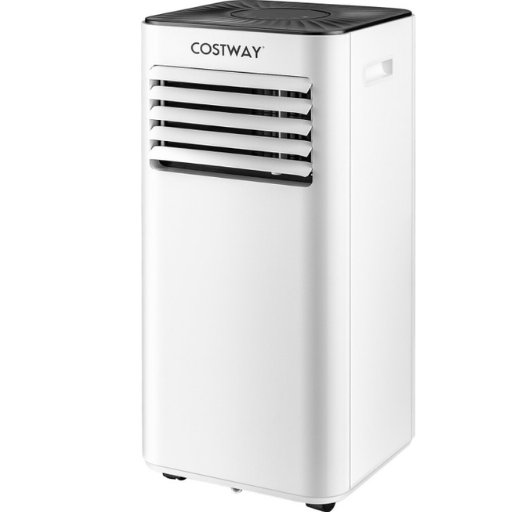
- Regular Cleaning
Clean the water reservoir, filter pads, and other parts regularly to prevent the buildup of dirt, debris, and mineral deposits. This ensures the cooler operates smoothly and avoids unpleasant odors.
- Check the Water Levels
Always maintain the correct water level in the reservoir to ensure proper cooling. Refill the water as needed, especially on hotter days when evaporation rates are higher.
- Inspect for Damage
Examine the filter pads, fan, and pump for any signs of wear or damage. Replace worn-out parts promptly to maintain efficiency.
- Seasonal Maintenance
Before the cooling season begins, perform a thorough inspection and cleaning. Similarly, when not in use, drain the water, clean the system, and store the cooler properly to avoid rust or damage.
- Ensure Adequate Ventilation
Position the cooler in a well-ventilated area and ensure that the outlet airflow reaches the intended spaces. Proper airflow helps the cooler function effectively.
By following these simple steps, you can extend the lifespan of your evaporative cooler while ensuring it operates at peak efficiency.
Regular Maintenance Tips for Cooling Systems
- Inspect and Clean Air Filters – Dirty air filters can significantly reduce the efficiency of your cooling system. Inspect filters monthly and clean or replace them as necessary. According to industry standards, a clean filter can lower energy consumption by 5-15%, improving both performance and cost-effectiveness.
- Check Refrigerant Levels – For systems that rely on refrigerants, low levels can strain the compressor and decrease cooling efficiency. Ensuring proper refrigerant levels can enhance system performance and prevent potential damage to crucial components.
- Examine and Seal Ductwork – Leaky ducts can lead to energy loss, with studies showing that up to 30% of energy is wasted this way in residential cooling systems. Periodically inspect ductwork for leaks and use appropriate sealants to prevent air loss.
- Clean Coils Regularly – Evaporator and condenser coils accumulate dirt and dust over time, reducing heat absorption and air circulation. Cleaning these coils annually can improve system efficiency and maintain consistent cooling output.
- Monitor Thermostat Performance – A malfunctioning thermostat can lead to inconsistent temperatures and reduced energy efficiency. Test thermostat functionality periodically and consider upgrading to a programmable or smart thermostat for better climate control and energy savings.
- Inspect Fan Blades and Belts – Ensure that fan blades are clean and balanced to avoid wear and tear on the system. Additionally, inspect belts for signs of cracking or fraying, replacing them as needed to maintain effective fan operation.
- Schedule Professional Tune-Ups – A biannual inspection by a certified professional can uncover hidden issues before they become major problems. Professionals can also test system efficiency and ensure that all components are operating at peak performance levels.
By following these maintenance tips, homeowners can reduce energy costs, ensure dependable performance during hot seasons, and extend the lifespan of their cooling systems. Keeping up with regular maintenance is an investment in comfort, efficiency, and long-term savings.
Ensuring Adequate Water Tank Levels and Cleanliness
Maintaining water tank levels and cleanliness is essential to ensuring a safe and consistent water supply for household and industrial needs. Regular monitoring of water levels prevents interruptions in water service and helps optimize usage efficiency, particularly in areas prone to water scarcity. According to industry standards, it’s advisable to inspect tank levels at least weekly, though automated systems equipped with level sensors can provide real-time monitoring and higher accuracy.
Water tank cleanliness plays a pivotal role in preventing contamination. Research shows that unclean tanks can harbor bacteria such as E. coli and other harmful pathogens, posing health risks to users. It’s recommended to clean water tanks every six months, removing debris, sediment, and any biofilm buildup. Using specialized cleaning agents or a mixture of household bleach and water can effectively disinfect tanks. After cleaning, ensure all cleaning agents and residues are thoroughly rinsed out to avoid contamination of the stored water.
Additionally, maintaining airtight tank covers serves to protect the water from external pollutants such as dust, pests, and algae growth caused by sunlight exposure. Where applicable, installing filters at the inlet and outlet points of the tank further enhances water quality by reducing sediment and other impurities. Prioritizing these practices is fundamental in securing a clean, reliable water supply, contributing to health, efficiency, and peace of mind for users.
Reference Sources
Frequently Asked Questions (FAQs)
Q: What is an evaporative air cooler dehumidifier?
A: An evaporative air cooler dehumidifier combines the principles of evaporation and dehumidification to provide cooling solutions. It cools the air by using water evaporation and simultaneously removes excess moisture, enhancing human comfort.
Q: How does the evaporation process work in these devices?
A: The evaporation process in these devices involves drawing in outdoor air and passing it over water-saturated pads. As the air absorbs the moisture, it cools down, providing an indirect evaporative cooling effect.
Q: Can an evaporative cooler also serve as a humidifier?
A: Yes, an evaporative cooler can increase indoor humidity levels, acting as a humidification device. However, specific models designed to serve both as coolers and dehumidifiers are available for balanced moisture control.
Q: How does an evaporative air cooler differ from a traditional air conditioner?
A: Unlike traditional air conditioners, which use refrigerants for cooling, evaporative air coolers use water evaporation to cool the air. This process is more energy-efficient and environmentally friendly, especially in dry climates.
Q: Is a swamp cooler the same as an evaporative air cooler?
A: Yes, a swamp cooler is another name for an evaporative air cooler. Both terms refer to the same device that cools air through the process of evaporation.
Q: Are there portable air conditioners with evaporative cooling features?
A: Yes, there are portable air conditioners that incorporate evaporative cooling features, allowing users to enjoy the benefits of both cooling technologies in a single, movable unit.
Q: How does a mist function enhance cooling in these devices?
A: The mist function in evaporative coolers adds a fine spray of water to the air, boosting the cooling effect. This helps in creating a more comfortable environment by increasing the cooling efficiency.
Q: Can evaporative air coolers be used as part of an HVAC system?
A: Yes, evaporative air coolers can be integrated into an HVAC system to provide energy-saving cooling and enhance heat recovery processes. They are particularly effective in arid regions as part of a holistic cooling strategy.
Q: What are the benefits of using an evaporative air cooler in terms of human comfort?
A: Evaporative air coolers enhance human comfort by providing fresh, cool air while maintaining optimal humidity levels. They are energy-efficient, cost-effective, and environmentally friendly, making them a popular choice for many households.

